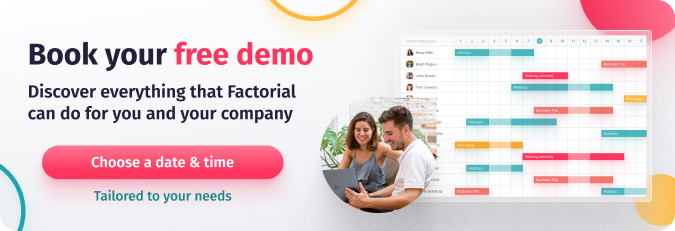Businesses use 12.2 trillion sheets of paper every year–accounting for over 50% of the total waste that they produce. And that’s not the only thing that’s wasted in the process. Without document management software, paper usage can be also a big financial drain for businesses.
A study by Gartner indicates that as much as 3% of a company’s revenue costs are spent on paper. Not to mention all of the hidden costs of paper usage, like the time and money spent organizing, locating, and storing paperwork.
With the right document management system in place, businesses can have the resources to accommodate more sustainable, efficient, and secure business models.
But what is document management software and how do businesses implement it?
In this article, we’ll go over the definition, features, and benefits of document management software, and provide step-by-step instructions on how to make the switch to a cloud-based document system. Lastly, we’ll go over how Factorial’s document management solution is used.
HR DMS: What is it?
Document management software (DMS), also known as EDMS, or employee record management software, is a paperless solution that centralizes document processes for organizations. Specifically, the storing, managing, signing, and sharing of employee and company files, contracts, and legal paperwork.
There are two types of Document management software: on-premises document management software and cloud-based document management software. Depending on your business model and compliance needs, one option might be better suited than the other. Typically, cloud-based solutions are more cost-effective and are a better choice for businesses looking to grow, as they allow users to access files from any location and at any time.
Why automate document management?
There are many reasons why businesses choose to automate document management. For one, automating document management makes daily processes more efficient and less wasteful. In this section, we’ll go through some of the biggest ways that businesses can benefit from going digital.
Increased Reliability
Operations are the backbone of any organization. By making your processes clear and organized, you are actually improving your internal and external communications and day-to-day interactions.
Your team will know how to access and share documents in a secure and reliable way. Whether the documents are related to recruitment, onboarding, or payroll, having a digital system means less back and forth, less hassle, and more confidence in a system that works.
Cost-effective
There are several ways that you can save by using a document management system. As previously mentioned, you can cut out numerous expenses tied to paper usage including:
- Office and storage space– Say goodbye to huge filing cabinets and rooms full of folders. The beauty of Document Management Software is that it takes up virtually no extra office space. This means that you can repurpose rooms and more effectively manage your resources.
- Paper and printing– Aside from being wasteful, printing out employee records and documents can get expensive. Especially if your team is reliant on paperwork to complete their daily tasks.
- Extra staff– Using a paperless document management system means that your employees are more autonomous. They can access and upload documents as they need them, without having to ask anyone to dig through records and search for things. By eliminating these mundane tasks, employers can better allocate their spending and resources.
Increased security
There are many data security threats that businesses regularly face. Often, sharing digital documents via email does not protect against cyber attacks, phishing, and other privacy concerns. Here are some of the ways that document management software can make your processes more secure:
- Access control- With paper systems and with Google Docs, you risk facing compliance issues, or even data breaches when handling sensitive information. With the right document management software, you can control permissions and determine who is authorized to access documents.
- Reduces errors- Papers can easily get misplaced and lost, and you run a greater risk of making small mistakes that can cost you a fortune. Systems like Factorial allow you to create custom files and organizational systems for each type of document. With a system like this, finding what you are looking for
- Clear documentation- With document management software, you can keep a more organized and clear track record of documents over time. If something does go wrong, and you need to conduct an audit of business processes, you’ll have all of the needed information clear and available.
Zero-waste solution
According to statistics collected by the St. Charles County of Mississippi, businesses in the United States use approximately 21 million tons of paper every year, that’s about 750,000 copies per minute. Stopwaste.org states that out of all trees harvested, 42% go towards making paper. Additionally, the pulp and paper industry is one of the largest water users and polluters in the United States. By reducing your company’s paper waste, you are also helping to alleviate several environmental problems, such as deforestation, water contamination, and carbon dioxide emissions.
Remote Work possibilities
Although there are many advantages to hybrid and remote work, many teams with digital workforces face more difficulties when it comes to business operations and communications. With the right document management software, team members can easily sign legal documents electronically and securely, meaning one less obstacle while managing from afar.
How to implement DMS
Although moving from a paper-based filing system to document management software might feel overwhelming at first, it can significantly simplify your long-term processes. Here are some of the steps to make the transition as smooth as possible.
1) Create folders for every type of document
The first step to effectively using document management software is creating a cohesive archival system for all of your files. This will most likely require inter-departmental collaboration, as many types of documents and organizational systems are already in place.
Rather than try to duplicate your existing processes, use this as an opportunity to create a better and more streamlined version. The goal is to make a system that is clear and intuitive to figure out. This might mean adopting company-wide nomenclature for files or simply dividing files by department.
2) Upload documents to your system
The next step includes uploading employee files, IDs, payslips, contracts, leaves, etc. If your company has an entirely paper system in place, the transition to scan and upload might initially be a lengthy process. Try to divide the material and work phase-by-phase. Having a system that allows you to upload files in bulk will speed up this process considerably.
3) Notify employees
Last but not least, you will need to have a way of notifying employees as soon as documents are uploaded and accessible. Employees should clearly understand how documents are stored, where they can find them, and (if the software allows for it) instructions on how to upload documents themselves. Systems that have built-in notification systems are advantageous when it comes to communicating with employees.
Common features
Document management systems come in all shapes and sizes. There are, however, some key features that you should be on the lookout for when finding the right fit for your team. The best document management systems have the following tools available:
Document repository
Document management software allows you to centralize and store all of your documents in a central repository. Therefore minimizing the time spent hunting for paperwork and reducing the possibility of documents getting lost.
Electronic signature (e-signature)
With electronic signatures, or “e-signatures”, users can quickly approve and complete legal documents with ease. Many businesses use document management software to request e-signatures for documents like contracts, legal agreements, payslips, and timesheets.
Automated workflows
Automated workflows allow managers to cut down on time and ensure that the right parties are reviewing the right documents. This feature allows users to determine “triggers” that allow actions to take place automatically. For example, when a contract signature receives approval, a manager receives a signed copy automatically.
Access management
Many document management systems also have a way of controlling and managing who can access documents. As mentioned before, this is critical to ensuring secure data processes and complying with privacy regulations.
Bulk actions
Document management systems that allow you to make changes in bulk can have a huge impact on the overall efficiency of your business operations. Basically, with this feature, you can upload and make changes to multiple documents at once. For example, if you need to create an extra field on 100 forms before sending them to your staff. With the bulk actions tool, there’s no need to make changes on each and every form individually. You can create the field on one form and simply duplicate the change for the other 99.
Factorial’s HR document management tool
If you want to ensure that company and employee documents are processed efficiently and securely, Factorial’s document management software is right for you. Our cloud-based software uses a powerful encryption system, so you can rest assured that employee data and legal documents are safe and protected. Additionally, you can communicate updates with employees, send document requests, build custom approval workflows, and create unique access permissions for users.
There are many Document management systems out there that provide users with basic storage and processing options. However, with Factorial’s all-in-one software for HR management, you can seamlessly process payslips, employee IDs, company contracts, and more. From recruitment to onboarding to payroll, Factorial’s software can help to cut out mundane administrative tasks and cut back on expenses. But don’t just take our word for it, request a demo to see how Factorial can work for you!


